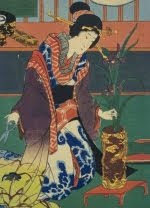Yusaku Kamekura, 1915-1997, has been called the father of Japanese graphic design, or in Japan's design world simply "The Boss". His work is distinguished by its dynamic composition, technical expertise and visual inventiveness, making full use of photography, colour and geometric elements. Two years after his first one-man show, he organized the famed Graphic '55 exhibition at the Takashimaya department store, introducing design into the vocabulary of the populace. (ref.
http://yusakukamekura.blogspot.com)
One of his best early poster designs is a 1954 color print advertisement intended to promote an upcoming flower arrangement exhibition by Sofu Teshigahara. Right now a very small size print of the exhibition poster is for sale on
eBay at a quite high price.
Sofu Teshigahara, 1954
Sofu Teshigahara was himself a leading personality in the postwar arts movement in Japan. The present Iemoto of the Sogetsu School, Akane Teshigahara, remembers the close and longlasting relationship between her grandfather Sofu, Kamekura and also the photographer
Ken Domon:
"I headed to Sakata to visit the “Three Artists, Three Minds” exhibition that is currently being held at Ken Domon Museum of Photography. Photographer Ken Domon, graphic designer Yusaku Kamekura, and my grandfather Sofu Teshigahara enjoyed a tight-knit relationship, often being referred to as “three brothers.” The sculpture produced by Sofu blended beautifully into the setting as though it had been commissioned specially for the space. It was a strangely fascinating sight." (ref. Akane Teshigahara's "A bunch of thoughts" Vol. 14, 2009/07/10)
The friendship also resulted in the 1977 book
Sannin Sanyou with essays by Teshigahara, Kamekura and Domon. This book is still available in Japanese and can be bought from the
Sogetsu web shop.
Outside Japan Yusaka Kamekura is best-known for his 1964 Tokyo Olympic Games posters and for Expo ’70 in Osaka. Here are a couple of my favorite Kamekura designs:
Nicon, Mikron Binoculars, 1955
Tokyo Olympic Games, 1964















